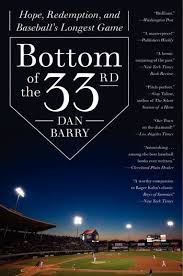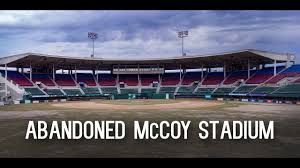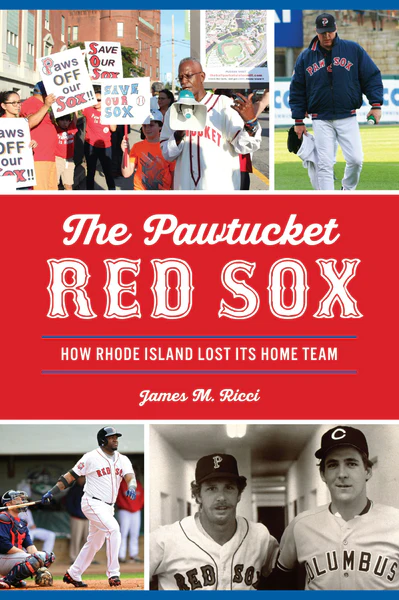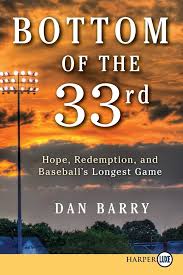Bottom of the 33rd (2011) by Dan Barry
Good Reads meta-data is 255 pages, rated 4.08 by 2,415 Scrooges.
Genre: Nonfiction; Species: ‘Informed Imagination.’
DNA: Horsehide, Grass, and Ash.

Verdict: Wonderful!
Tagline: Hope. Frustration. Redemption. Resignation. Life.
Things went wrong from the start. In the dilapidated stadium, the lights would not go on for the 7:30 pm start time. An ominous portent. When a technician summoned on that cold night of April 18, 1981, Saturday before Easter Sunday, found a way to turn them on, the payback was that they remained on … until 4 a.m the next day. The site of this marathon was McCoy Stadium of P’tucket in the Ocean State of Rhode Island.

Stop right there! Any 108-stitch baseball fan knows that date and place. If not, get thee to Cooperstown, right now!
In this early season AAA International League game the Pawtucket Red Sox hosting the Rochester Red Wings (Orioles) entered the Twilight Zone with no way out. Jean-Paul Sartre said, in Hui Clos, ‘Hell is other people’ (Amen!), in this case it was another inning. And another. Thirty-three times, while each team waited for Godot to deliver the game winning hit and to set them free.

‘Baseball is life and life is baseball’ sums up this story of the players, umpires, fans, families, passers-by, owners, managers caters, groundskeepers, who populated this bittersweet moment, ah, hours, and hours, as the temperature fell. If life has meaning, debatable I know, then so does baseball, and, perhaps, vice-versa, if baseball has meaning, then so does life.
What brought these people together in this performance of the theatre of the absurd? How did they react to this Sisyphean labour? Where did they go after this purgatory? Did those endless innings scar them for life? Some answers to these questions are gleaned in micro-biographies on more than a dozen of them.

Taking this extraordinary game, the longest ever played in ‘organised baseball’ (i.e., the North American Major Leagues and their minor league affiliates), as a case study, the author dissects the allure of the diamond for players (who hope to rise to the top in MLB, or reluctantly realise that they are sinking not rising), spectators, families, batboys, teenage girls in the concession stands, and lonely old men who prefer to sit apart in the stands.
The result is a tour de force.
In the course of the game, it is clear that some players are destined for the Elysian fields of the Bigs, while others need a day job – soon. The hopes of the latter have grown old and brittle in an Odyssean journey around the minor leagues; among them is an infielder for whom the Red Wings is the fourteenth team he has played for in just over a decade of wandering through the minor leagues, earning just enough…to need a working wife. At twenty-eight or even twenty-five, most of these men are baseball-old, in a game where youth is almost everything.
At times it is the team manager’s job to tell one of them that this is it. He will never ascend. Yes, he can hit. Yes, his glove is good. All true here in AAA. But the rosters are full of just such athletes, and he does not stand out among them. Enjoy the moment, because – look up – the curtin is falling ever faster with each birthday.

Pedant’s Corner. It seems the curfew rule was accidentally omitted from the AAA Umpire’s Handbook that year, and so the umpires had no express authority to end the game.
* * *
The author did impressive research with even more impressive empathy, developing biographies of dozens the participants it seemed, giving many of them their own voice from the inside out to reflect on baseball, that game, and their lives. It is touching, amusing, and poignant all at once.
Needless to say, but say it I will, the pygmies have reviewed it on Good Reads. (Apologies to pygmies for the comparison. If someone can suggest another metaphor for the small-minded gnomes who just have to criticise for its own sake to feel, briefly, smart, please let me know below.)
P.S. One golden summer while I was in college, I was the official scorer at Legion games for the local paper, and I read much of this story from the standpoint of that job. How in the world would a scorer fit at 33-inning game into a scorebook. The ones I used allowed 3 extra innings. Moreover, how would a publishing deadline be met. Ah, yes, the author not only explains how this scorer dealt with these problems but shows us the result. Ingenious, if nearly inscrutable.

